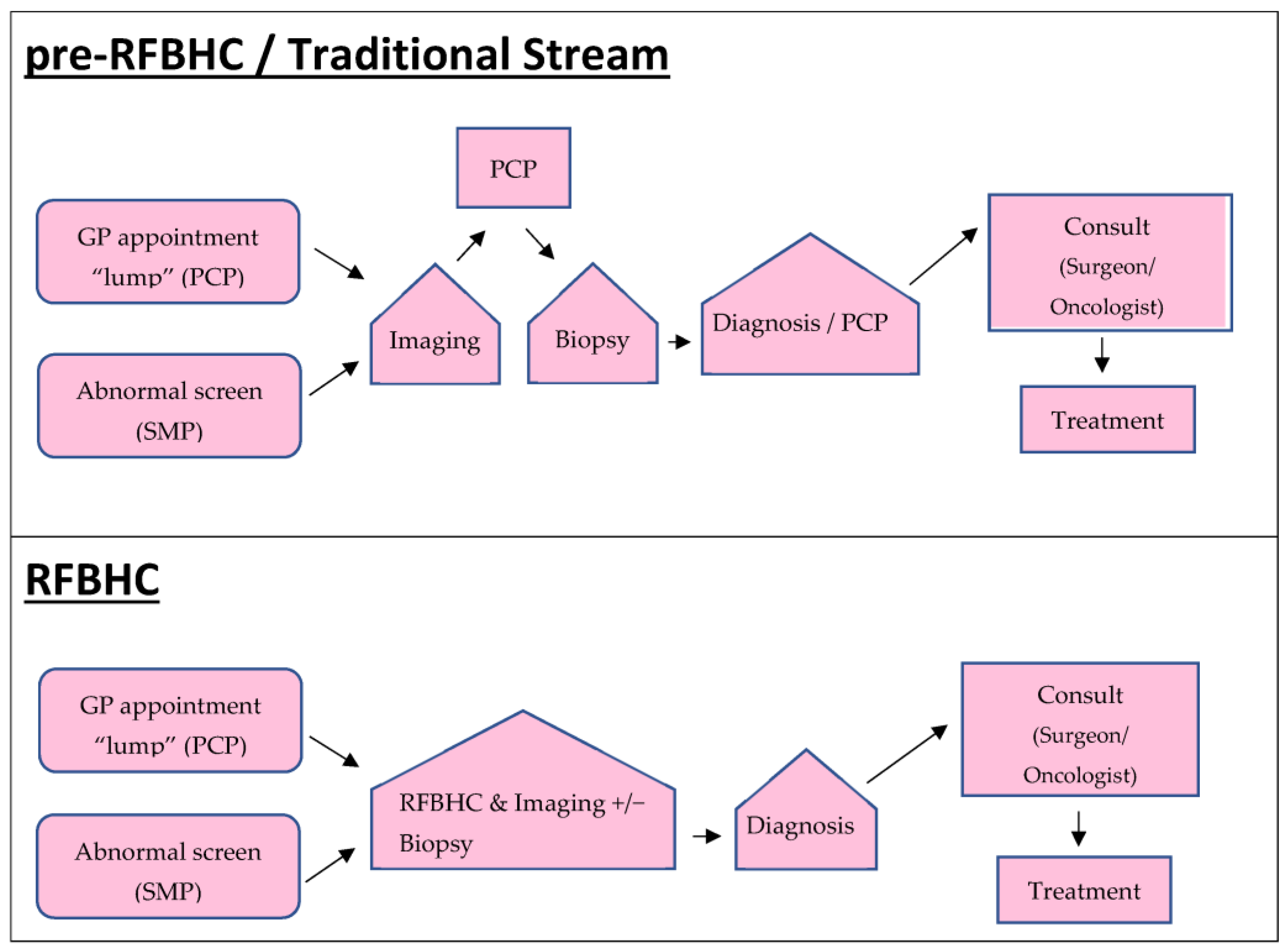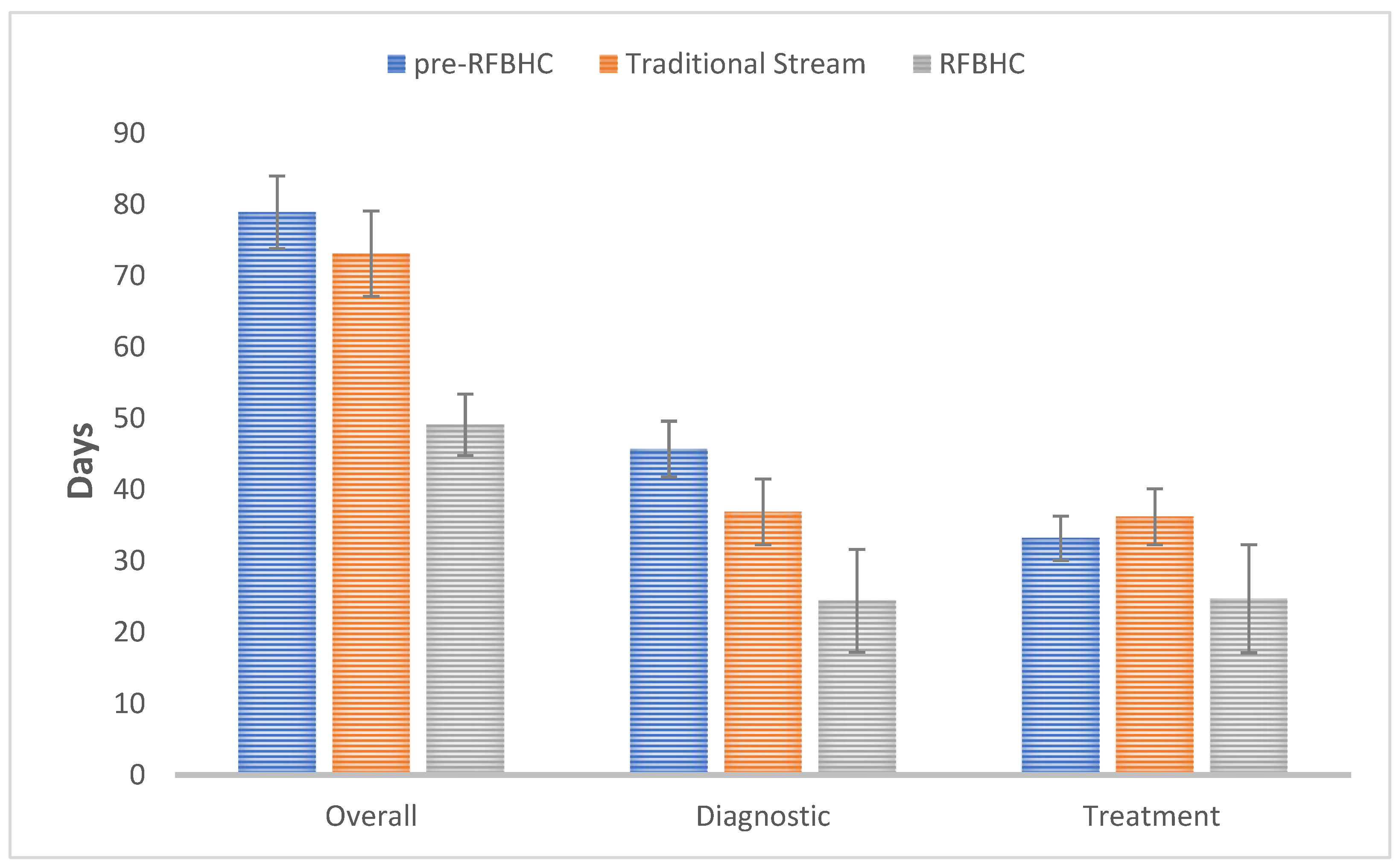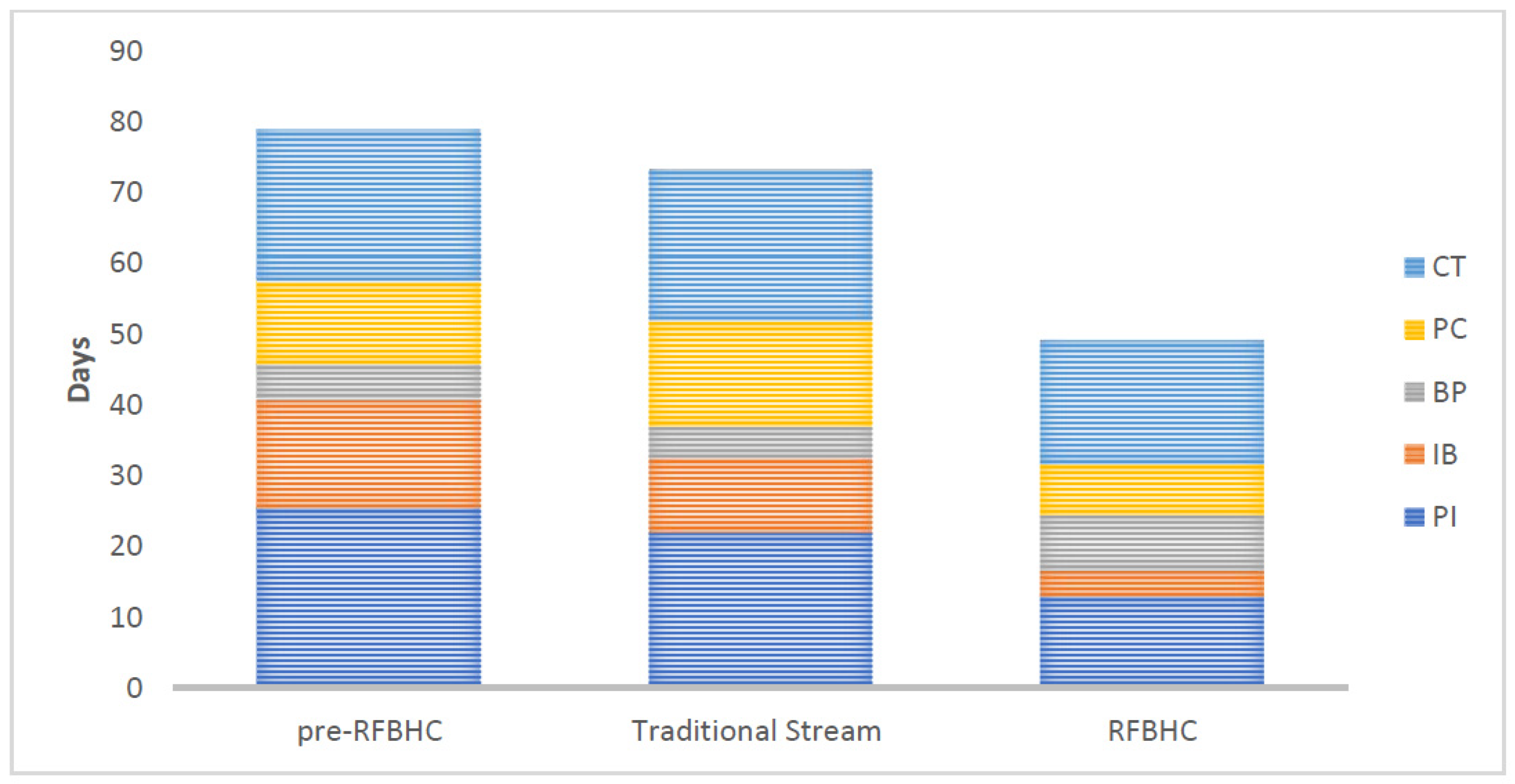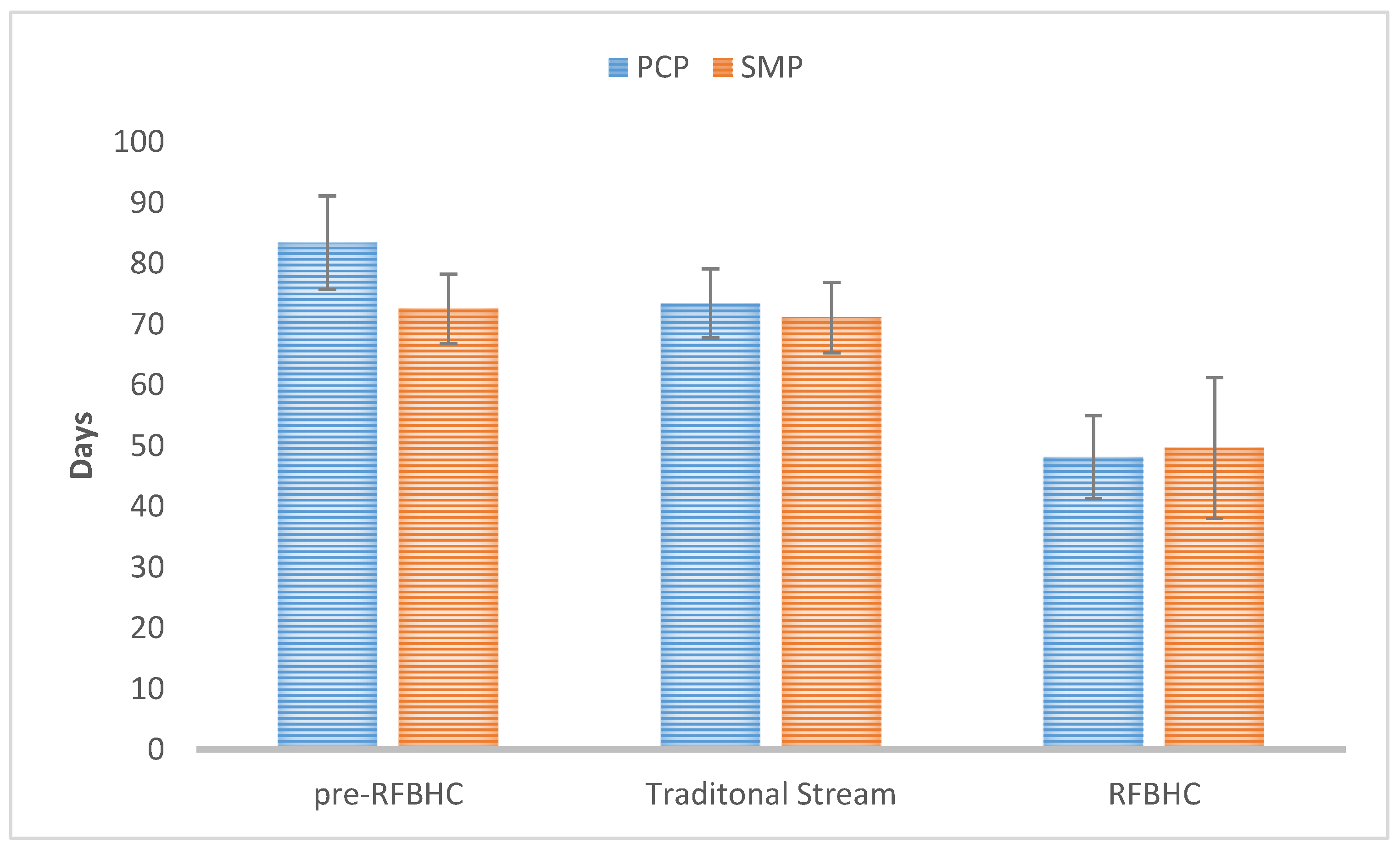Assurance of Timely Access to Breast Cancer Diagnosis and Treatment by a Regional Breast Health Clinic Serving Both Urban and Rural-Remote Communities
Abstract
1. Introduction
2. Methods
3. Results
- Compared to the pre-RFBHC group, the RFBHC group had a 29.8 days shorter mean overall wait time (49.1 vs. 78.9 days, p ≤ 0.001), 21.3 days shorter mean diagnostic wait time (24.4 vs. 45.7 days, p ≤ 0.001), and 8.5 days shorter mean treatment wait time (24.7 vs. 33.2 days, p = 0.037).
- After the establishment of the RFBHC and compared to the Traditional Stream group, the RFBHC group had a 24.0 days shorter mean overall wait time (49.1 vs. 73.1 days, p ≤ 0.001), 12.5 days shorter mean diagnostic wait time (24.4 vs. 36.9 days, p = 0.004), and 11.5 days shorter mean treatment wait time (24.7 vs. 36.2 days, p = 0.007).
- Compared to the pre-RFBHC group, the Traditional stream group had an 8.8 days shorter mean diagnostic wait time (36.9 vs. 45.7 days, p = 0.004), but no significant differences were found in overall wait time (73.1 vs. 78.9 days, p = 0.146) or treatment wait time (36.2 vs. 33.2 days, p = 0.220).
- Compared to the pre-RFBHC group, the RFBHC group had on average: 12.4 days shorter wait time from presentation to imaging (13.0 vs. 25.4 days, p ≤ 0.001), 11.7 days shorter wait time from imaging to biopsy (3.6 vs. 15.3 days, p ≤ 0.001), and 4.0 days shorter wait time from consult to treatment (17.5 vs. 21.5 days, p = 0.019). No significant differences were found in wait times from biopsy to pathology (7.8 vs. 5.0 days, p = 0.415) or from pathology to consult (7.2 vs. 11.7 days, p = 0.228).
- After the RFBHC establishment and compared to the Traditional Stream group, the RFBHC group had on average: 9.0 days shorter wait time from presentation to imaging (13.0 vs. 22.0 days, p ≤ 0.001), 6.9 days shorter wait time from imaging to biopsy (3.6 vs. 10.5 days, p ≤ 0.001), 7.7 days shorter wait time from pathology to consult (7.2 vs. 14.9 days, p = 0.045), and 3.8 days shorter wait time from consult to treatment (17.5 vs. 21.3 days, p = 0.042). Wait time differences from biopsy to pathology were not statistically significant (7.8 vs. 4.4 days, p = 0.320).
- Compared to the pre-RFBHC group, the Traditional stream group had on average: 4.8 days shorter wait time from imaging to biopsy (10.5 vs. 15.3, p ≤ 0.001) and 3.2 days longer wait time from pathology to consult (14.9 vs. 11.7 days, p = 0.040). No statistically significant differences were found from presentation to imaging (22.0 vs. 25.4, p = 0.190), biopsy to pathology (4.4 vs. 5.0, p = 0.094), or consult to treatment (21.3 vs. 21.5, p = 0.901).
4. Discussion
5. Conclusions
Author Contributions
Funding
Institutional Review Board Statement
Informed Consent Statement
Data Availability Statement
Conflicts of Interest
References
- McKevitt, E.C.; Dingee, C.K.; Leung, S.-P.; Brown, C.J.; Van Laeken, N.Y.; Lee, R.; Kuusk, U. Reduced Time to Breast Cancer Diagnosis with Coordination of Radiological and Clinical Care. Cureus 2017, 9, e1919. [Google Scholar] [CrossRef] [PubMed]
- Pelletier, L. Provincial Breast Health Strategy Summary Report; Provincial Health Services Authority: Vancouver, BC, Canada, 2012. [Google Scholar]
- Flores-Balcázar, C.H.; Flores-Luna, M.L.; Villarreal-Garza, C.M.; Bargalló-Rocha, J.E. Provider delay in treatment initiation and its influence on survival outcomes in women with operable breast cancer. Rep. Pract. Oncol. Radiother. 2020, 25, 271–275. [Google Scholar] [CrossRef]
- Ho, P.J.; Cook, A.R.; Binte Mohamed Ri, N.K.; Liu, J.; Li, J.; Hartman, M. Impact of delayed treatment in women diagnosed with breast cancer: A population-based study. Cancer Med. 2020, 9, 2435–2444. [Google Scholar] [CrossRef]
- Yung, R.; Ray, R.M.; Roth, J.; Johnson, L.; Warnick, G.; Anderson, G.L.; Kroenke, C.H.; Chlebowski, R.T.; Simon, M.S.; Fung, C.; et al. The association of delay in curative intent treatment with survival among breast cancer patients: Findings from the Women’s Health Initiative. Breast Cancer Res. Treat. 2020, 180, 747–757. [Google Scholar] [CrossRef] [PubMed]
- Bleicher, R.J. Timing and Delays in Breast Cancer Evaluation and Treatment. Ann. Surg. Oncol. 2018, 25, 2829–2838. [Google Scholar] [CrossRef] [PubMed]
- Eriksson, L.; Bergh, J.; Humphreys, K.; Wärnberg, F.; Törnberg, S.; Czene, K. Time from breast cancer diagnosis to therapeutic surgery and breast cancer prognosis: A population-based cohort study. Int. J. Cancer 2018, 143, 1093–1104. [Google Scholar] [CrossRef] [PubMed]
- Mansfield, S.A.; Abdel-Rasoul, M.; Terando, A.M.; Agnese, D.M. Timing of Breast Cancer Surgery-How Much Does It Matter? Breast J. 2017, 23, 444–451. [Google Scholar] [CrossRef]
- Webber, C.; Jiang, L.; Grunfeld, E.; Groome, P.A. Identifying predictors of delayed diagnoses in symptomatic breast cancer: A scoping review. Eur. J. Cancer Care 2017, 26, e12483. [Google Scholar] [CrossRef]
- Richards, M.; Westcombe, A.; Love, S.; Littlejohns, P.; Ramirez, A. Influence of delay on survival in patients with breast cancer: A systematic review. Lancet 1999, 353, 1119–1126. [Google Scholar] [CrossRef]
- McGarvey, N.; Gitlin, M.; Fadli, E.; Chung, K.C. Increased healthcare costs by later stage cancer diagnosis. BMC Health Serv. Res. 2022, 22, 1155. [Google Scholar] [CrossRef]
- Blumen, H.; Fitch, K.; Polkus, V. Comparison of Treatment Costs for Breast Cancer, by Tumor Stage and Type of Service. Am. Health Drug Benefits 2016, 9, 23–32. [Google Scholar] [PubMed]
- Pineault, P. Breast Cancer Screening: Women’s Experiences of Waiting for Further Testing. Oncol. Nurs. Forum 2007, 34, 847–853. [Google Scholar] [CrossRef]
- Boudreau, R.M.; McNally, C.; Rensing, E.M.; Campbell, M.K. Improving the Timeliness of Written Patient Notification of Mammography Results by Mammography Centers. Breast J. 2004, 10, 10–19. [Google Scholar] [CrossRef] [PubMed]
- Ganz, P.A. Quality of Life Across the Continuum of Breast Cancer Care. Breast J. 2000, 6, 324–330. [Google Scholar] [CrossRef] [PubMed]
- Thorne, S.E.; Harris, S.R.; Hislop, T.G.; Vestrup, J.A. The Experience of Waiting for Diagnosis after an Abnormal Mammogram. Breast J. 1999, 5, 42–51. [Google Scholar] [CrossRef] [PubMed]
- Biganzoli, L.; Cardoso, F.; Beishon, M.; Cameron, D.; Cataliotti, L.; Coles, C.E.; Bolton, R.C.D.; Trill, M.D.; Erdem, S.; Fjell, M.; et al. The requirements of a specialist breast centre. Breast 2020, 51, 65–84. [Google Scholar] [CrossRef]
- Biganzoli, L.; Marotti, L.; Hart, C.D.; Cataliotti, L.; Cutuli, B.; Kühn, T.; Mansel, R.E.; Ponti, A.; Poortmans, P.; Regitnig, P.; et al. Quality indicators in breast cancer care: An update from the EUSOMA working group. Eur. J. Cancer 2017, 86, 59–81. [Google Scholar] [CrossRef]
- Guler, S.A.; Güllüoğlu, B.M. Quality Assurance in Breast Health Care and Requirement for Accreditation in Specialized Units. J. Breast Health 2014, 10, 129–133. [Google Scholar] [CrossRef]
- Wilson, A.; Marotti, L.; Bianchi, S.; Biganzoli, L.; Claassen, S.; Decker, T.; Frigerio, A.; Goldhirsch, A.; Gustafsson, E.; Mansel, R.; et al. The requirements of a specialist Breast Centre. Eur. J. Cancer 2013, 49, 3579–3587. [Google Scholar] [CrossRef]
- Perry, N.; Broeders, M.; de Wolf, C.; Törnberg, S.; Holland, R.; von Karsa, L. European guidelines for quality assurance in breast cancer screening and diagnosis. Fourth edition—Summary document. Ann. Oncol. 2008, 19, 614–622. [Google Scholar] [CrossRef]
- Winchester, D.P. The United States’ national accreditation program for breast centers: A model for excellence in breast disease evaluation and management. Chin. Clin. Oncol. 2016, 5, 313. [Google Scholar] [CrossRef] [PubMed]
- Kaufman, C.S.; Quality Initiative Committee; Shockney, L.; Rabinowitz, B.; Coleman, C.; Beard, C.; Landercasper, J.; Askew, J.B.; Wiggins, D. National Quality Measures for Breast Centers (NQMBC): A Robust Quality Tool. Ann. Surg. Oncol. 2010, 17, 377–385. [Google Scholar] [CrossRef]
- Webber, C.; Whitehead, M.; Eisen, A.; Holloway, C.; Groome, P. Breast Cancer Diagnosis and Treatment Wait Times in Specialized Diagnostic Units Compared with Usual Care: A Population-Based Study. Curr. Oncol. 2020, 27, e377–e385. [Google Scholar] [CrossRef]
- Blackmore, K.M.; Weerasinghe, A.; Holloway, C.M.B.; Majpruz, V.; Mirea, L.; O’Malley, F.P.; Harris, C.P.; Hendry, A.; Hey, A.; Kornecki, A.; et al. Comparison of wait times across the breast cancer treatment pathway among screened women undergoing organized breast assessment versus usual care. Can. J. Public Health 2019, 110, 595–605. [Google Scholar] [CrossRef]
- Jiang, L.; Gilbert, J.; Langley, H.; Moineddin, R.; Groome, P.A. Breast cancer detection method, diagnostic interval and use of specialized diagnostic assessment units across Ontario, Canada. Health Promot. Chronic Dis. Prev. Can. 2018, 38, 358–367. [Google Scholar] [CrossRef] [PubMed]
- Chiarelli, A.M.; Muradali, D.; Blackmore, K.M.; Smith, C.R.; Mirea, L.; Majpruz, V.; O’Malley, F.P.; Quan, M.L.; Holloway, C.M. Evaluating wait times from screening to breast cancer diagnosis among women undergoing organised assessment vs usual care. Br. J. Cancer 2017, 116, 1254–1263. [Google Scholar] [CrossRef] [PubMed]
- Jiang, L.; Gilbert, J.; Langley, H.; Moineddin, R.; Groome, P.A. Effect of specialized diagnostic assessment units on the time to diagnosis in screen-detected breast cancer patients. Br. J. Cancer 2015, 112, 1744–1750. [Google Scholar] [CrossRef] [PubMed]
- McKevitt, E.C.; Dingee, C.K.; Warburton, R.; Pao, J.S.; Brown, C.; Wilson, C.; Kuusk, U. Coordination of Radiologic and Clinical Care Reduces the Wait Time to Breast Cancer Diagnosis. Curr. Oncol. 2017, 24, 388–393. [Google Scholar] [CrossRef]
- Racz, J.; Holloway, C.; Huang, W.; Hong, N.L. Improving Patient Flow and Timeliness in the Diagnosis and Management of Breast Abnormalities: The Impact of a Rapid Diagnostic Unit. Curr. Oncol. 2016, 23, 260–265. [Google Scholar] [CrossRef][Green Version]
- Baliski, C.; McGahan, C.E.; Liberto, C.M.; Broughton, S.; Ellard, S.; Taylor, M.; Bates, J.; Lai, A. Influence of nurse navigation on wait times for breast cancer care in a Canadian regional cancer center. Am. J. Surg. 2014, 207, 686–692. [Google Scholar] [CrossRef]
- Psooy, B.J.; Schreuer, D.; Borgaonkar, J.; Caines, J.S. Patient navigation: Improving timeliness in the diagnosis of breast abnormalities. Can. Assoc. Radiol. J. 2004, 55, 145–150. [Google Scholar] [PubMed]
- Landercasper, J.; Linebarger, J.H.; Ellis, R.L.; Mathiason, M.A.; Johnson, J.M.; Marcou, K.A.; De Maiffe, B.M.; Jago, G.S. A Quality Review of the Timeliness of Breast Cancer Diagnosis and Treatment in an Integrated Breast Center. J. Am. Coll. Surg. 2010, 210, 449–455. [Google Scholar] [CrossRef] [PubMed]
- Castellanos, M.R.; Conte, J.; Fadel, D.A.; Raia, C.; Forte, F.; Ahern, K.; Smith, M.; ElSayeh, D.; Buchbinder, S. Improving Access to Breast Health Services with an Interdisciplinary Model of Care. Breast J. 2008, 14, 353–356. [Google Scholar] [CrossRef] [PubMed]
- Argenbright, K.; Anderson, R.P.; Senter, M.; Lee, S.C. Breast Screening and Patient Navigation in Rural Texas Counties—Strategic Steps. Tex. Public Health J. 2012, 65, 25–27. [Google Scholar]
- Depke, J.L.; Boreen, A.; Onitilo, A.A. Navigating the Needs of Rural Women with Breast Cancer: A Breast Care Program. Clin. Med. Res. 2015, 13, 149–155. [Google Scholar] [CrossRef]
- Inrig, S.J.; Higashi, R.T.; Tiro, J.A.; Argenbright, K.E.; Lee, S.J.C. Assessing local capacity to expand rural breast cancer screening and patient navigation: An iterative mixed-method tool. Eval. Program Plan. 2017, 61, 113–124. [Google Scholar] [CrossRef]
- Inrig, S.J.; Tiro, J.A.; Melhado, T.V.; Argenbright, K.E.; Lee, S.J.C. Evaluating a De-Centralized Regional Delivery System for Breast Cancer Screening and Patient Navigation for the Rural Underserved. Tex. Public Health J. 2014, 66, 25–34. [Google Scholar]
- Obeng-Gyasi, S.; Obeng-Gyasi, B.; Tarver, W. Breast Cancer Disparities and the Impact of Geography. Surg. Oncol. Clin. N. Am. 2022, 31, 81–90. [Google Scholar] [CrossRef] [PubMed]
- Sprague, B.L.; Ahern, T.P.; Herschorn, S.D.; Sowden, M.; Weaver, D.L.; Wood, M.E. Identifying key barriers to effective breast cancer control in rural settings. Prev. Med. 2021, 152, 106741. [Google Scholar] [CrossRef]
- Williams, F.; Jeanetta, S.; James, A. Geographical Location and Stage of Breast Cancer Diagnosis: A Systematic Review of the Literature. J. Health Care Poor Underserved 2016, 27, 1357–1383. [Google Scholar] [CrossRef]
- Youl, P.H.; Aitken, J.F.; Turrell, G.; Chambers, S.K.; Dunn, J.; Pyke, C.; Baade, P.D. The Impact of Rurality and Disadvantage on the Diagnostic Interval for Breast Cancer in a Large Population-Based Study of 3202 Women in Queensland, Australia. Int. J. Environ. Res. Public Health 2016, 13, 1156. [Google Scholar] [CrossRef]
- Yuan, Y.; Li, M.; Yang, J.; Elliot, T.; Dabbs, K.; Dickinson, J.A.; Fisher, S.; Winget, M. Factors related to breast cancer detection mode and time to diagnosis in Alberta, Canada: A population-based retrospective cohort study. BMC Health Serv. Res. 2016, 16, 65. [Google Scholar] [CrossRef] [PubMed]
- Williams, F.; Jeanetta, S.; O’Brien, D.; Fresen, J. Rural-urban difference in female breast cancer diagnosis in Missouri. Rural Remote Health 2015, 15, 206–218. [Google Scholar] [CrossRef]
- Keeton, K.M.; Jones, E.S.; Sebastian, S. Breast Cancer in Mississippi: Impact of Race and Residential Geographical Setting on Cancer at Initial Diagnosis. South. Med. J. 2014, 107, 510–512. [Google Scholar] [CrossRef] [PubMed]
- Leung, J.; McKenzie, S.; Martin, J.; McLaughlin, D. Effect of rurality on screening for breast cancer: A systematic review and meta-analysis comparing mammography. Rural Remote Health 2014, 14, 260–272. [Google Scholar] [CrossRef]
- John, P.S.; Menec, V.; Tate, R.; Newall, N.; O’Connell, M.; Cloutier, D. Functional status in rural and urban adults: The Canadian Longitudinal Study on Aging. J. Rural Health 2021, 38, 679–688. [Google Scholar] [CrossRef]
- Kornelsen, J.; Khowaja, A.R.; Av-Gay, G.; Sullivan, E.; Parajulee, A.; Dunnebacke, M.; Egan, D.; Balas, M.; Williamson, P. The rural tax: Comprehensive out-of-pocket costs associated with patient travel in British Columbia. BMC Health Serv. Res. 2021, 21, 854. [Google Scholar] [CrossRef]
- Kornelsen, J.; Carthew, C.; Míguez, K.; Taylor, M.; Bodroghy, C.; Petrunia, K.; Roberts, D. Rural citizen-patient priorities for healthcare in British Columbia, Canada: Findings from a mixed methods study. BMC Health Serv. Res. 2021, 21, 987. [Google Scholar] [CrossRef]
- Wong, S.; Regan, S. Patient perspectives on primary health care in rural communities: Effects of geography on access, continuity and efficiency. Rural Remote Health 2009, 9, 1142. [Google Scholar] [CrossRef]
- Shuswap, T.C.; Health, P.H.; Status, S.; Care, A. Health Service Delivery Area Profile; Interior Health: Kelowna, BC, Canada, 2020. [Google Scholar]
- Nigam, M.; Nigam, B. Triple Assessment of Breast—Gold Standard in Mass Screening for Breast Cancer Diagnosis. IOSR J. Dent. Med. Sci. 2013, 7, 1–7. [Google Scholar] [CrossRef]
- Quan, M.; Finley, C. Pan-Canadian Standards for Breast Cancer Surgery; Canadian Partnership against Cancer: Toronto, ON, Canada, 2019. [Google Scholar]
- Canadian Partnership against Cancer. Report from the Evaluation Indicators Working Group: Guidelines for Monitoring Breast Cancer Screening Program Performance, 3rd ed.; Canadian Partnership against Cancer: Toronto, ON, Canada, 2013. [Google Scholar]
- Provincial Health Services Authority. Breast Health Action Plan; PHSA: Vancouver, BC, Canada, 2010. [Google Scholar]
- Health Quality Ontario. Primary Care Patient Experience Survey; Version 4-2015; HQO: Toronto, ON, Canada, 2015; Primary-care-patient-experience-survey-en.pdf (hqontario.ca). [Google Scholar]
- Health Quality Ontario. Primary Care Patient Experience Survey: Support Guide; HQO: Toronto, ON, Canada, 2015; Primary Health Care Patient Experience Survey: Toolkit/Support Guide (hqontario.ca). [Google Scholar]
- Cha, J.; McKevitt, E.; Pao, J.-S.; Dingee, C.; Bazzarelli, A.; Warburton, R. Access to surgery following centralization of breast cancer surgical consultations. Am. J. Surg. 2020, 219, 831–835. [Google Scholar] [CrossRef] [PubMed]





| Source | Milestone | Wait Time Standard | Target Compliance |
|---|---|---|---|
| Pan-Canadian Standards for Breast Cancer Surgery | Symptoms to Pathology | 6 weeks | 90% |
| Pathology to Consult | 2 weeks | 90% | |
| Consult to Treatment | 4 weeks | 90% | |
| Canadian National Breast Cancer Screening Strategy (Current BC Standard) | Symptoms to Pathology | 7 weeks | 90% |
| BC Provincial Breast Health Strategy Summary Report (Recommended BC Standard) | Symptoms to Pathology | 4 weeks | 90% |
| Characteristics | Description | Pre-RFBHC | RFBHC Established: Traditional Stream | RFBHC Established: Referred to RFBHC | Full Cohort |
| Age | Mean ± 95% CI | 64.4 ± 1.3 | 64.2 ± 2.6 | 63.4 ± 2.1 | 64.2 ± 1.0 |
| Median (Q2 to Q3) | 66.0 (56.0 to 72.0) | 65.5 (54.5 to 74.0) | 62.5 (57.0 to 70.0) | 65.0 (57.0 to 72.0) | |
| Number of Patients | 327 | 104 | 108 | 539 | |
| Location | Kamloops | 222 (67.9%) | 63 (60.6%) | 77 (71.3%) | 362 (67.2%) |
| Outside of Kamloops | 105 (32.1%) | 41 (39.4%) | 31 (28.7%) | 177 (32.8%) | |
| Source of Referral | Primary Care Provider | 191 (59.0%) | 89 (85.6%) | 39 (36.1%) | 321 (59.6%) |
| Screening Mammography Program | 134 (41.0%) | 15 (14.4%) | 69 (63.9%) | 218 (40.4%) | |
| Pathologic Diagnosis | Invasive Ductal Adenocarcinoma | 251 (76.8%) | 74 (71.2%) | 74 (68.5%) | 399 (74.0%) |
| DCIS | 48 (14.7%) | 21 (20.2%) | 14 (13.0%) | 83 (15.4%) | |
| Lobular Carcinoma | 28 (8.6%) | 9 (8.7%) | 20 (18.5%) | 57 (10.6%) |
| Standard | Milestone Interval | Pre-RFBHC | RFBHC Established: Traditional Stream | RFBHC Established: Referred to RFBHC |
| Pan-Canadian Standards for Breast Cancer Surgery | Symptoms to Pathology (90% within 6 weeks) | 203/327 (62.1%) Referent | 74/104 (71.2%) p = 0.093 | 99/108 (91.7%) p ≤ 0.001 |
| Pathology to Consult (90% within 2 weeks) | 231/327 (70.6%) Referent | 61/104 (58.7%) p = 0.023 | 84/108 (77.8%) p = 0.151 | |
| Consult to Treatment (90% within 4 weeks) | 263/327 (80.4%) Referent | 80/104 (76.9%) p = 0.441 | 96/108 (88.9%) p = 0.045 | |
| Canadian National Breast Cancer Screening Strategy (Current BC standard) | Symptoms to Pathology (90% within 7 weeks) | 230/327 (70.3%) Referent | 81/104 (77.9%) p = 0.135 | 102/108 (94.4%) p ≤ 0.001 |
| BC Provincial Breast Health Strategy Summary Report (Recommended BC standard) | Symptoms to Pathology (90% within 4 weeks) | 115/327 (35.2%) Referent | 46/104 (44.2%) p = 0.097 | 89/108 (82.4%) p ≤ 0.001 |
Disclaimer/Publisher’s Note: The statements, opinions and data contained in all publications are solely those of the individual author(s) and contributor(s) and not of MDPI and/or the editor(s). MDPI and/or the editor(s) disclaim responsibility for any injury to people or property resulting from any ideas, methods, instructions or products referred to in the content. |
© 2023 by the authors. Licensee MDPI, Basel, Switzerland. This article is an open access article distributed under the terms and conditions of the Creative Commons Attribution (CC BY) license (https://creativecommons.org/licenses/by/4.0/).
Share and Cite
Ewart, E.; Barton, A.; Chen, L.; Cuthbert, R.; Toplak, K.; Burrows, A. Assurance of Timely Access to Breast Cancer Diagnosis and Treatment by a Regional Breast Health Clinic Serving Both Urban and Rural-Remote Communities. Curr. Oncol. 2023, 30, 1232-1242. https://doi.org/10.3390/curroncol30010095
Ewart E, Barton A, Chen L, Cuthbert R, Toplak K, Burrows A. Assurance of Timely Access to Breast Cancer Diagnosis and Treatment by a Regional Breast Health Clinic Serving Both Urban and Rural-Remote Communities. Current Oncology. 2023; 30(1):1232-1242. https://doi.org/10.3390/curroncol30010095
Chicago/Turabian StyleEwart, Elizabeth, Anise Barton, Leo Chen, Ross Cuthbert, Kaitlin Toplak, and Andrea Burrows. 2023. "Assurance of Timely Access to Breast Cancer Diagnosis and Treatment by a Regional Breast Health Clinic Serving Both Urban and Rural-Remote Communities" Current Oncology 30, no. 1: 1232-1242. https://doi.org/10.3390/curroncol30010095
APA StyleEwart, E., Barton, A., Chen, L., Cuthbert, R., Toplak, K., & Burrows, A. (2023). Assurance of Timely Access to Breast Cancer Diagnosis and Treatment by a Regional Breast Health Clinic Serving Both Urban and Rural-Remote Communities. Current Oncology, 30(1), 1232-1242. https://doi.org/10.3390/curroncol30010095





